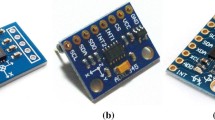Abstract
Large sensor installations are becoming prominent as the cost of sensors drop and new methods are developed for structural health monitoring, fall detection, building occupancy, etc. Large amounts of data could be quickly captured, especially for measurements of high sampling rate such as acceleration signals. Methods to quickly triage records for further analysis can be used to drastically reduce the amount of data to be process. This paper studies the use of Support Vector Machines to classify floor vibration signals to determine signals of interest. Four kernels and three signal metrics were explored in this research using a human activity dataset containing over 500,000 acceleration records. Results show that the Radial Basis Function using a Dispersion Ratio metric can be used to identify signals of interest effectively.







Similar content being viewed by others
References
Ko J, Ni Y (2005) Technology developments in structural health monitoring of large-scale bridges. Eng Struct 27(12):1715–1725
Ni Y, Xia Y, Liao W, Ko J (2009) Technology innovation in developing the structural health monitoring system for guangzhou new tv tower. Struct Control Health Monit 16(1):73–98
USGS: National strong motion project (2017). https://earthquake.usgs.gov/monitoring/nsmp/
Pan S, Bonde A, Jing J, Zhang L, Zhang P, Noh HY (2014) Boes: building occupancy estimation system using sparse ambient vibration monitoring. SPIE Smart Structures and Materials+ Nondestructive Evaluation and Health Monitoring pp 90611O–90611O
Schloemann J, Malladi VS, Woolard AG, Hamilton JM, Buehrer RM, Tarazaga PA (2015) Vibration event localization in an instrumented building. In: Experimental Techniques, Rotating machinery, and Acoustics, vol 8. Springer, pp 265–271
Jang S, Jo H, Cho S, Mechitov K, Rice JA, Sim SH, Jung HJ, Yun CB, Spencer BF Jr, Agha G (2010) Structural health monitoring of a cable-stayed bridge using smart sensor technology: deployment and evaluation. Smart Structures and Systems
Rice JA, Mechitov K, Sim SH, Nagayama T, Jang S, Kim R, Spencer BF Jr, Agha G, Fujino Y (2010) Flexible smart sensor framework for autonomous structural health monitoring. Smart Structures and Systems
Alwan M, Rajendran PJ, Kell S, Mack D, Dalal S, Wolfe M, Felder R (2006) A smart and passive floor-vibration based fall detector for elderly. In: Information and Communication Technologies, 2006. ICTTA ’06. 2nd, vol 1. pp 1003–1007. https://doi.org/10.1109/ICTTA.2006.1684511
Klenk J, Becker C, Lieken F, Nicolai S, Maetzler W, Alt W, Zijlstra W, Hausdorff J, van Lummel R, Chiari L, Lindemann U (2011) Comparision of acceleration signals of simulated and real-world backward falls. Med Eng Phys 33:368–373. https://doi.org/10.1016/j.medengphy.2010.11.003
Zigel Y, Litvak D, Gannot I (2009) A method for automatic fall detection of elderly people using floor vibrations and sound - proof od concept on human mimicking doll falls. IEEE Transactions on Biomedical Engineering 56(12). https://doi.org/10.1109/TBME.2009.2030171
Davis BT (2016) Characterization of human-induced vibrations. Ph.D. thesis, University of South Carolina
Khan S, Pathan ASK, Alrajeh NA (2012) Wireless Sensor Networks: Current Status and Future Trends, 1st edn. CRC Press, Boca Raton
Boser BE, Guyon IM, Vapnik VN (1992) A training algorithm for optimal margin classifiers. In: Proceedings of the Fifth Annual Workshop on Computational Learning Theory, COLT ’92. ACM, New York, pp 144–152. https://doi.org/10.1145/130385.130401
Cortes C, Vapnik V (1995) Support-vector networks. Mach Learn 20(3):273–297. https://doi.org/10.1023/A:1022627411411
Guyon I, Boser B, Vapnik V (1993) Automatic capacity tuning of very large vc-dimension classifiers. In: Advances in Neural Information Processing Systems, Morgan Kaufmann, pp 147– 155
Han R, Jia Z, Qin X, Chang C, Wang H (2009) Application of support vector machine to mobile communications in telephone traffic load of monthly busy hour prediction. In: 2009 Fifth International Conference on Natural Computation, vol 3. pp 349–353. https://doi.org/10.1109/ICNC.2009.96
Wu TF, Lin CJ, Weng RC (2004) Probability estimates for multi-class classification by pairwise coupling. J Mach Learn Res 5:975–1005
Sewell M Support vector machines (svms) (2006). http://www.svms.org/
Son YJ, Kim HG, Kim EH, Choi S, Lee SK (2010) Application of support vector machine for prediction of medication adherence in heart failure patients. Healthcare Informatics Research 16:253–259. https://doi.org/10.4258/hir.2010.16.4.253
Noble WS (2006) What is a support vector machine. Nat Biotechnol 24(12):1565–1567. https://doi.org/10.1038/nbt1206-1565
Scikit-Learn Developers: Support vector machines (2015). http://scikit-learn.org/stable/modules/svm.html#
Bunkley N (2008) Joseph juran, 103, pioneer in quality control dies. http://www.nytimes.com/2008/03/03/business/03juran.html?_r=0
Acknowledgements
This work is partially supported by a grant from the University of South Carolina Magellan Scholar Program, and additional partial support is provided by a grant from the Alzheimer’s Association (ETAC-10-174499).
This work was supported in part by VISN 7, US Department of Veterans Affairs. Also, William Jennings Bryan Dorn VAMC facilitated the conduct of the study in the hospital and patient homes. The contents do not represent the views of the US Department of Veterans Affairs or the US Government.
This material is based upon work supported by the National Science Foundation Graduate Research Fellowship Program under Grant Number 1450810. Any opinions, findings, and conclusions or recommendations expressed in this material are those of the author(s) and do not necessarily reflect the views of the National Science Foundation.
Author information
Authors and Affiliations
Corresponding author
Additional information
Publisher’s Note
Springer Nature remains neutral with regard to jurisdictional claims in published maps and institutional affiliations.
Rights and permissions
About this article
Cite this article
Davis, B.T., Caicedo, J.M., Hirth, V.A. et al. Acceleration Signal Categorization Using Support Vector Machines. Exp Tech 43, 359–368 (2019). https://doi.org/10.1007/s40799-019-00318-y
Received:
Accepted:
Published:
Issue Date:
DOI: https://doi.org/10.1007/s40799-019-00318-y




